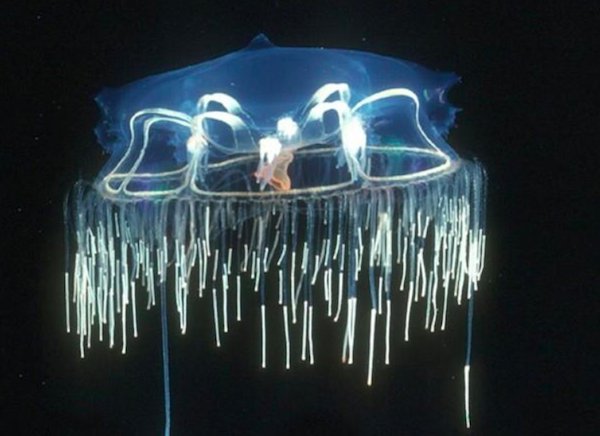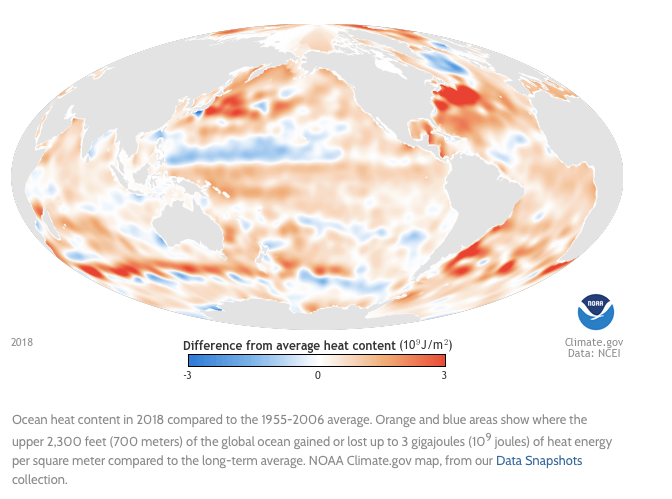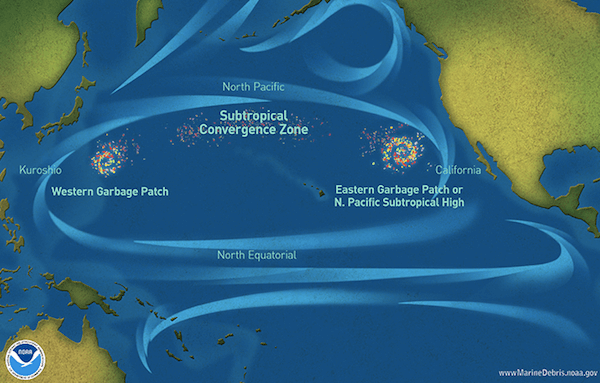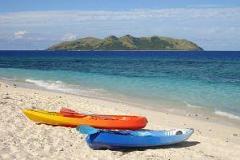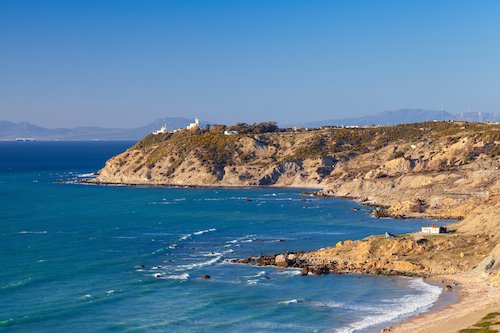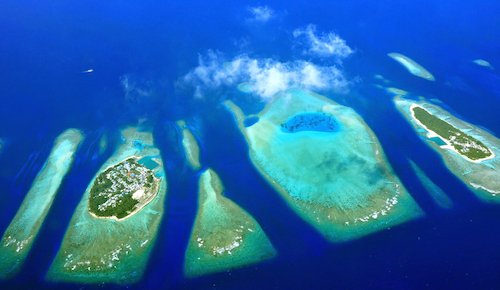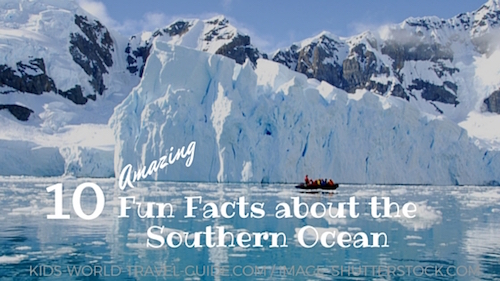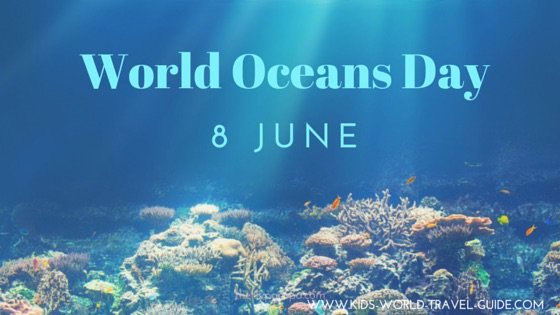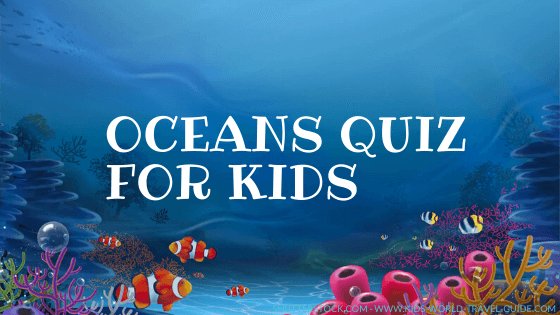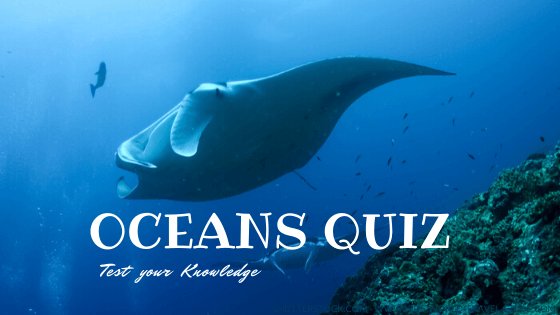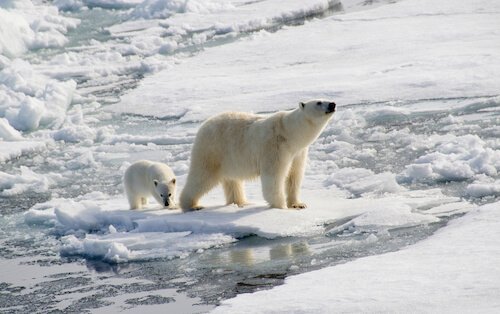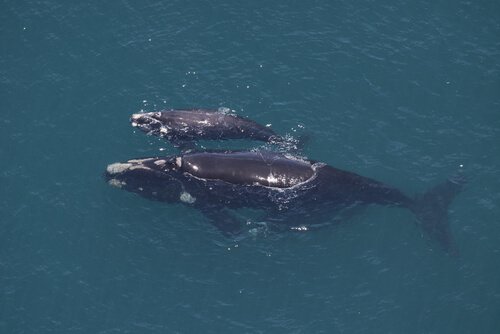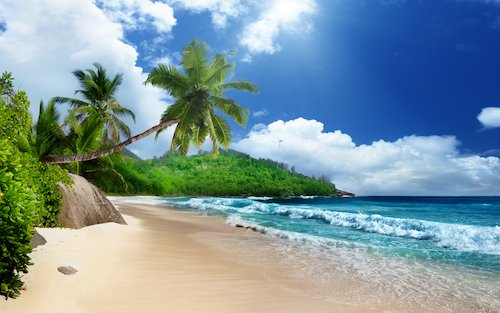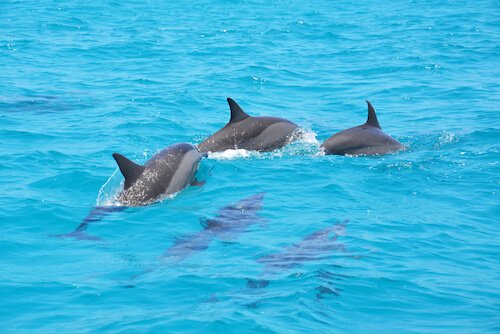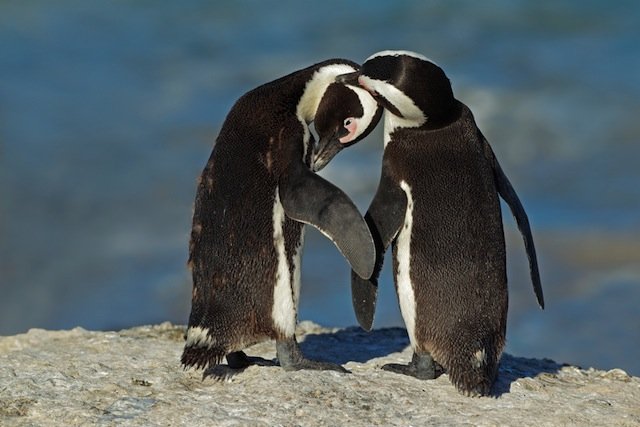- Homepage
- Ocean Facts
- 20 Ocean Facts
Ocean Facts
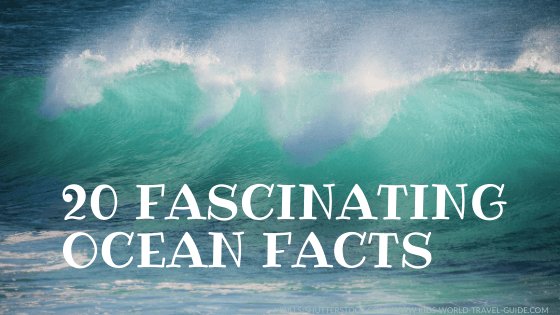
Our Ocean Facts will provide plenty of information about our world oceans. We will tell you here what you really should know about the oceans. First let's start with some basics!
Facts about the Oceans
The ocean is our life support system as the ocean regulates our climate, absorbs the dangerous carbon dioxide and generates the oxygen we need to breathe.
The World Ocean accounts for 97% of all water that exists on our planet - the other 3 % is freshwater locked up in the ice caps, rivers and lakes. So this is our lifeline and we have to make sure to look after the health of our oceans.
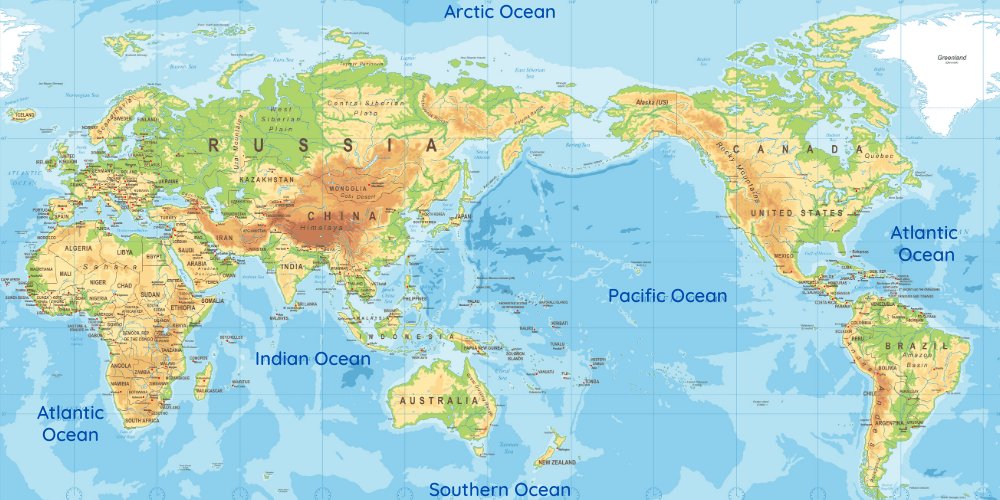
How many oceans are there? There are five oceans and seven continents that cover the surface of our planet.
In fact, there is only one World Ocean, one big water mass surrounding the seven continents, however, the ocean has been divided into five ocean basins according to geographic location and these basins are commonly referred to as the five oceans.
The five oceans are the Arctic Ocean, Atlantic Ocean, Indian Ocean, Pacific Ocean and Southern Ocean.
The world's five main ocean basins cover over 71% of the Earth's surface.
20 Ocean facts everybody should know
1. Which is the largest ocean of the five oceans?
The largest ocean of the world is the Pacific Ocean. The Pacific Ocean covers more than 30% of our planet's surface.
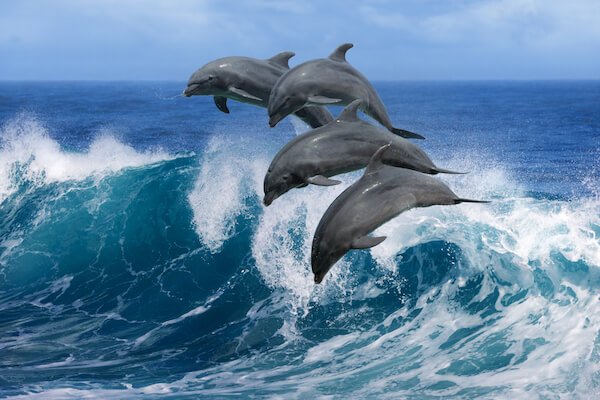 Dolphins frolicking in the Pacific Ocean
Dolphins frolicking in the Pacific Ocean2. Where are the ocean boundaries of the five oceans?
As the oceans' water surface encircles our continents across the globe, the ocean boundaries are a concept that has evolved over time. For a long time there were four oceans recognised, only in the year 2000 the boundaries of the Southern Ocean were established and agreed upon.
- The Southern Ocean is located around the South Pole across the Antarctic circle in the Southern Hemisphere off the Antarctica coast. It extends up to 60° latitude and then borders the Atlantic, Pacific and Indian Oceans.
- The official border of the Atlantic Ocean and Indian Ocean is at Cape Agulhas/South Africa.
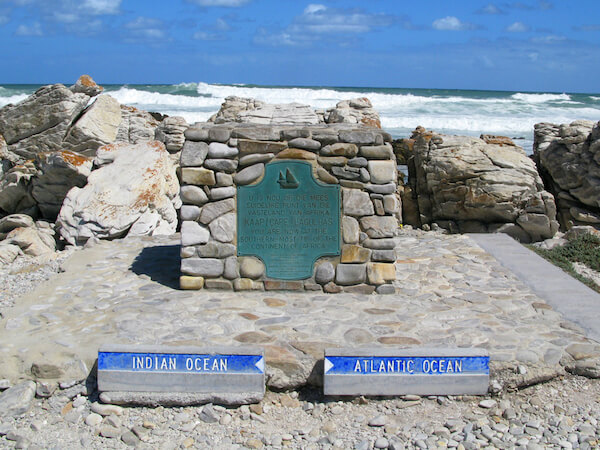 Cape Agulhas in South Africa
Cape Agulhas in South Africa- The Arctic Ocean lies to the North of Greenland, Norway, Russia, Alaska and Canada.
- The Indian Ocean meets the Pacific Ocean off the islands in Indonesia and to the South of Tasmania/Australia.
- The Pacific Ocean meets the Atlantic waters south of Cape Horn which is the southernmost tip of Tierra del Fuego/South America.
3. Ocean Facts | How deep are the oceans?
The average depth of the oceans is about 3,500 m/ 11,482 ft. However, the depth of the oceans varies widely depending on the location on the tectonic plates. Ocean trenches are deep depressions on the ocean floor that are found in all ocean basins and the places where tectonic plates meet. In general, the deepest ocean is the Pacific Ocean.
The deepest ocean area is found in the Mariana Trench in the western Pacific Ocean near Guam.
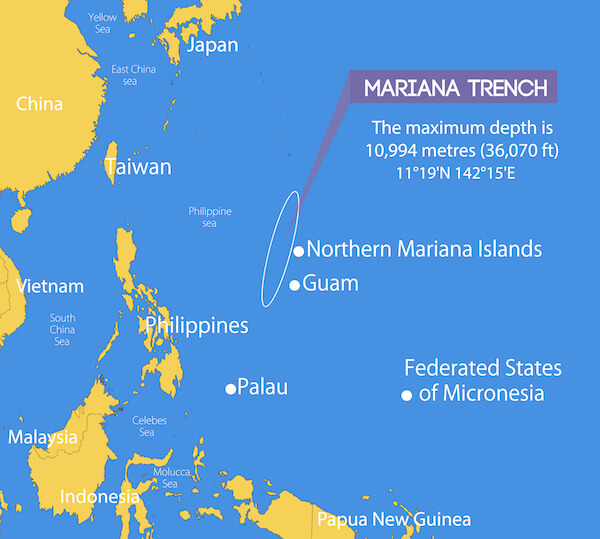
Mariana Trench is about 2,250 km/ 1,398 miles long and 69 km/42 miles wide. Challenger Deep, as the deepest point of Mariana Trench is called, has a depth of 10,920 m or 35,827 ft!
The longest underwater mountain range is the Mid-Atlantic Ridge and it spreads from Iceland to Antarctica beneath the Atlantic Ocean.
4. What is the Deep Sea?
The Deep Sea starts about below 200 metres/ 656 ft below sea level where the sunlight fades away. The twilight zone ends about 1,000 m/ 3280 ft below sea level.
No light reaches deeper and it is dark there. To survive in the deep ocean, marine life has to adapt and there are some fascinating creatures as the jellyfish you see below.
Did you know that about 84% of all ocean water are part of the Deep Sea? About 50% of all our marine waters are deeper than 3,000 m/ 9,842 ft.
5. What is the Pacific Ocean's 'Ring of Fire'?
The 'Ring of Fire' is an area of high geological activity that is located on the rim of the Pacific Basin.
In the Pacific Ocean the movement of the tectonic plates have caused deep trenches and the plates' movement continuously causes volcanic eruptions and earthquakes. The explosive activity of the volcanoes along the Ring of Fire often lead to devastating earthquakes, tsunamis, land- and mudslides or flooding.
The most underwater volcanos are found in the Pacific Ocean. At least 450 active and dormant volcanoes exist under the ocean floor. Actually 75% of all volcanic activity on our planet happens in the oceans!
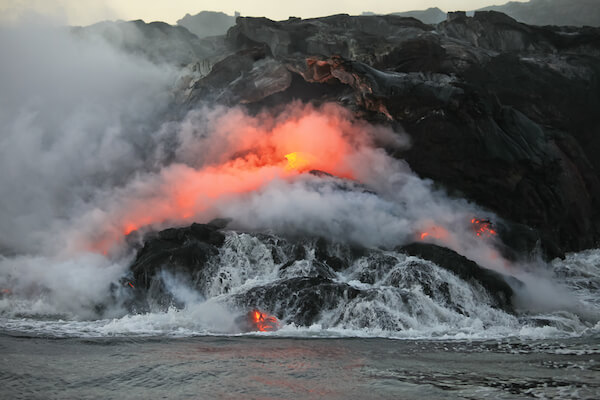 Volcanic eruption on Hawaii
Volcanic eruption on Hawaii6. Ocean Facts | How many animal species live in the oceans?
About 243,000 animal species live in the world's oceans. They account for roughly 16% of all species discovered so far on our planet.
Most marine species live in tropical waters where sea temperatures are stable and less affected by climate change. Seals and whales, however, thrive in cold waters and thus are mostly found in polar regions. Polar species struggle the most with climate change and rising temperatures.
The biggest creature of the ocean is the blue whale. Blue whales are found in all oceans, but due to whaling, overfishing and sea water pollution they are an endangered species.
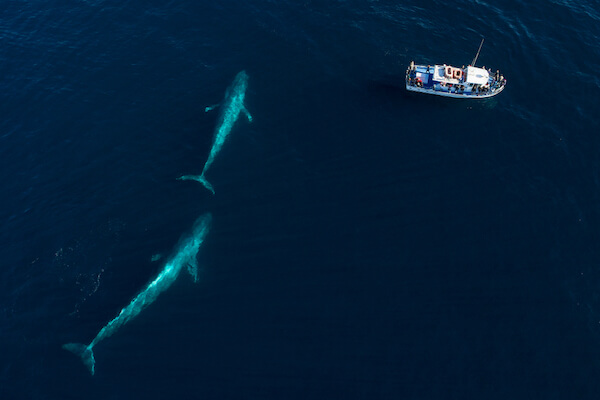
Did you know that a blue whale can weigh as much as 33 elephants?
Penguins can only be found in oceans in the southern hemisphere while polar bears are endemic only in oceans the northern hemisphere.
7. Ocean Facts | Which is the largest coral reef?
The largest coral reef in the world is located in the Pacific Ocean off the Australian coast. It is called the Great Barrier Reef. In size, the Great Barrier Reefis as big as 70 million football fields! Or in comparison, it is slightly bigger than the land area of Italy or slightly smaller than Germany. But as the Great Barrier Reef stretches over a length of over 2,300 km/ 1,430 miles, that would be about the distance along the coast from Hamburg/Germany to Lisbon/Portugal!
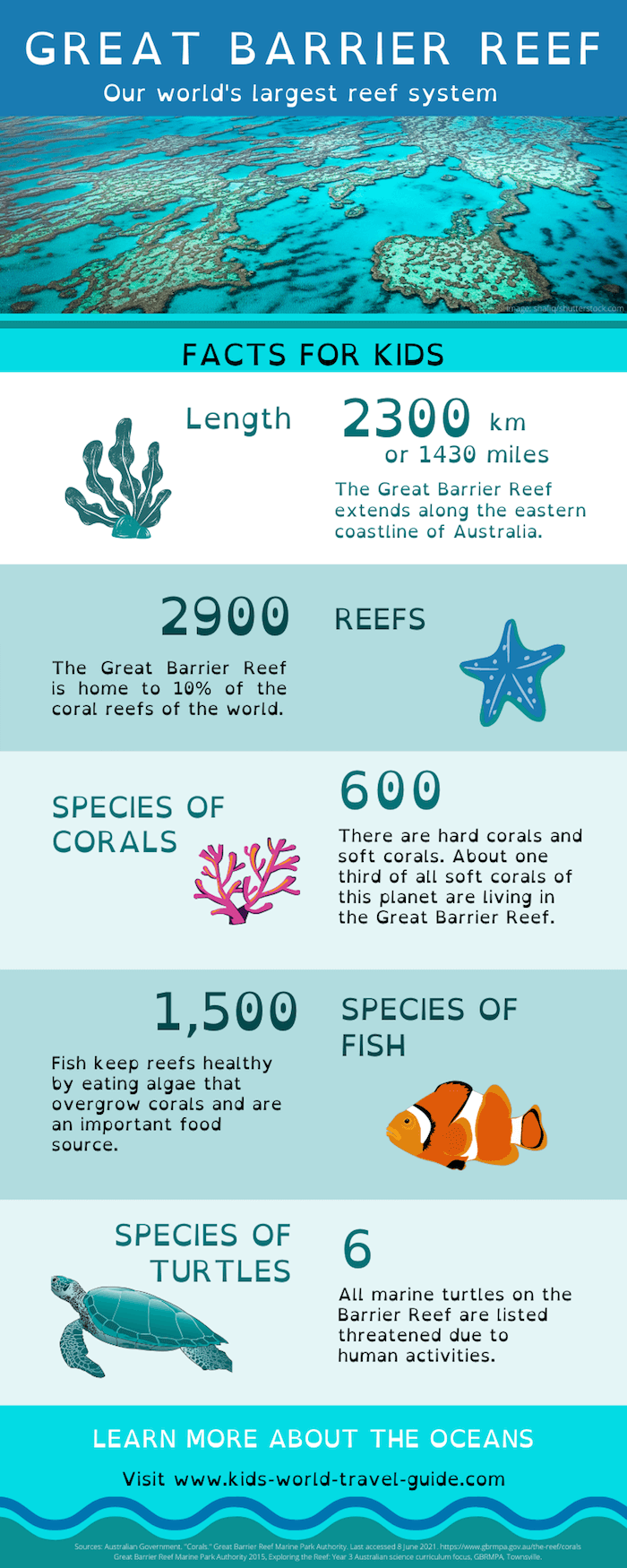
Ocean Facts: Coral Reef
Coral reefs are referred to as the nurseries of the oceans as they are hotspots of biodiversity. The highest biodiversity in any ocean is found in the Pacific Ocean. In the Pacific Ocean, there are the most coral species and also the highest amounts of marine life. Twice as many coral species live in the Pacific Ocean compared to the Atlantic Ocean.
Corals are only thriving in the warm waters of tropical oceans at around 23 - 29°C/ 73 - 84°F. If ocean water temperatures are higher for longer times, coral bleaching takes place.
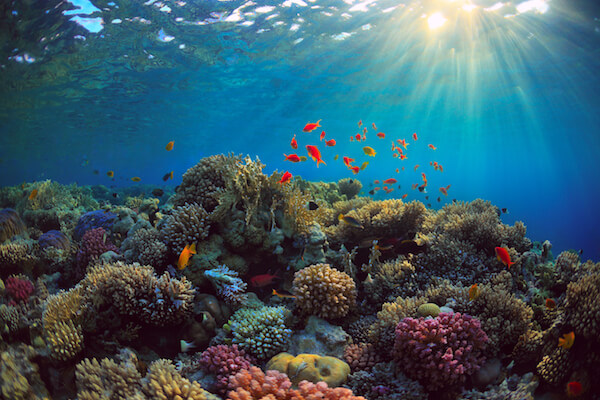
8. How warm are the oceans?
The temperatures in the world's oceans range widely. From -2°C/ 28°F in the Arctic and Antarctic waters up to 28°C/ 82°F in the Tropics. In general, ocean water is warmer closer to the shore and near hydrothermal vents.
Due to climate change, ocean water temperatures rise is experienced and this will inevitably also lead to sea level rise. See below how sea temperatures have affected the ocean temperatures.
Warm and cold ocean currents also influence the temperature of the ocean waters.
9. What is to know about ocean currents?
Ocean currents are movements of water in the oceans due to the gravity and rotation of the earth which is called 'coriolis effect'. Ocean currents are important in controlling our climate as they distribute the heat from the equator to the poles. They are important to sea life as they carry nutrients and food.
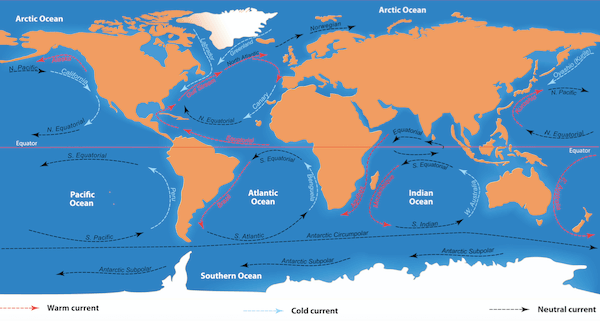 Oceanic Currents
Oceanic CurrentsDid you know that ocean water moves clockwise in the northern hemisphere and anti-clockwise in the southern hemisphere? Warm ocean currents flow away from the equator and cold currents flow from the poles towards the equator.
10. Are there countries that have areas below sea- level?
Three quarters of the world's countries border an ocean and of these, 22 countries border two or more oceans.
And about one in eight countries have at least some areas that are located below sea-level. Many of these areas or depressions are located in remote or unpopulated regions.
However, some countries are at high risk for flooding as bigger areas of the country are located below sea-level. In the Netherlands, about one third of the land area is below sea-level!
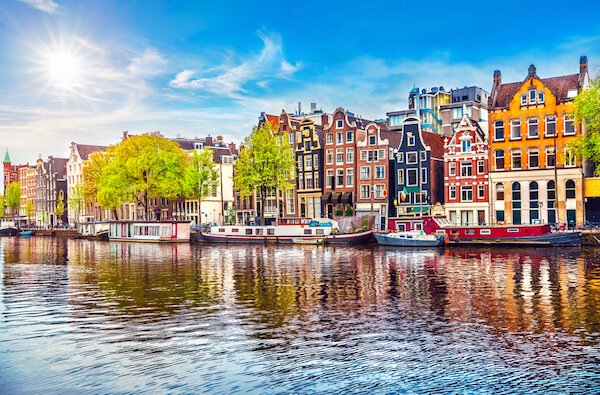 Houses in Amsterdam along the Amstel river
Houses in Amsterdam along the Amstel riverAmong the world's major cities below sea-level are Baku/Azerbaijan, New Orleans/USA and Amsterdam/Netherlands.
11. How many people live close to the oceans?
Almost half of the world population (44%) live within 150 km/ 93 miles of the coast. Eight of the ten largest cities in the world are located along a coastline. Coastal areas and ocean cities will most be affected by the predicted sea level rise due to climate change.
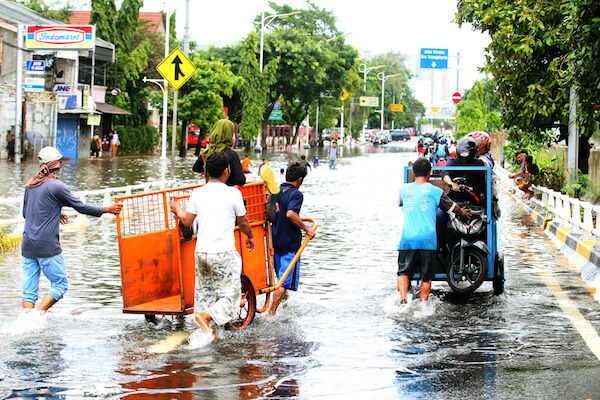 Flooding in Jakarta - image by Fendi Anggoro
Flooding in Jakarta - image by Fendi AnggoroJakarta in Indonesia is known as the 'fastest sinking city in the world'
12. How does climate change affect ocean cities?
Among the biggest ocean cities are Tokyo, Mumbai, New York or Shanghai or Lagos. Ocean cities are particularly exposed to natural hazards, including storms, tropical cyclones, earthquakes, tsunamis and volcanic activity. All these dangerous phenomena will become more regular with climate change.
By 2050 many cities around the world will be affected by flooding, among them Houston and New Orleans/USA, Rotterdam/Netherlands, Bangkok/Thailand, Dhaka/Bangladesh and Venice/Italy.
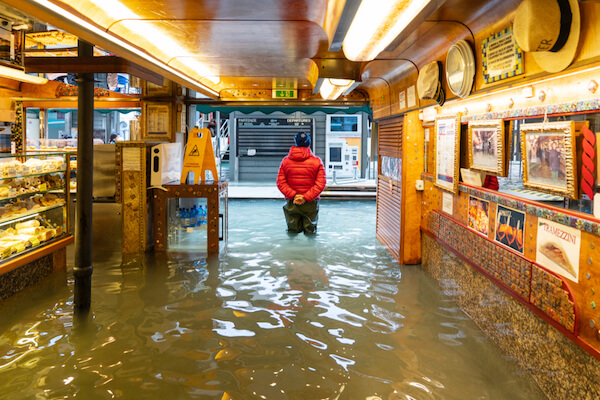 Flooded shop in Venice in 2019 - image by Ihor Serdyukov
Flooded shop in Venice in 2019 - image by Ihor SerdyukovBy 2100, about 200 million people will live in cities below sea level. People in low lying areas in coastal regions will be most affected by raising sea levels and climate change.
13. Which is the biggest ocean island?
The biggest ocean island is Greenland. Australia is commonly referred to as a continent and not an island.
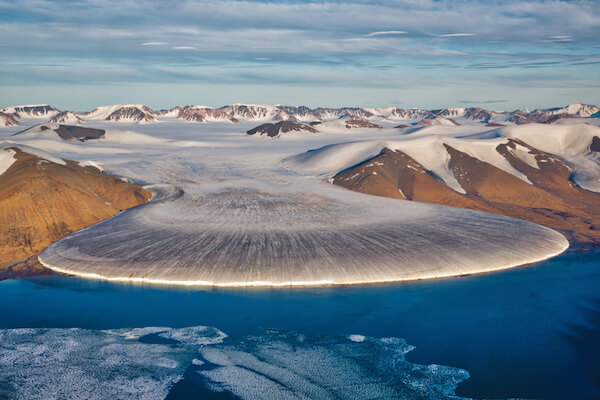 Glacier in Greenland
Glacier in Greenland14. Which ocean has the most islands?
The Pacific Ocean houses most of the islands in the world. There are about 25,000 islands in the Pacific Ocean. The islands entirely within the Pacific Ocean can be divided into three main groups known as Micronesia, Melanesia and Polynesia.
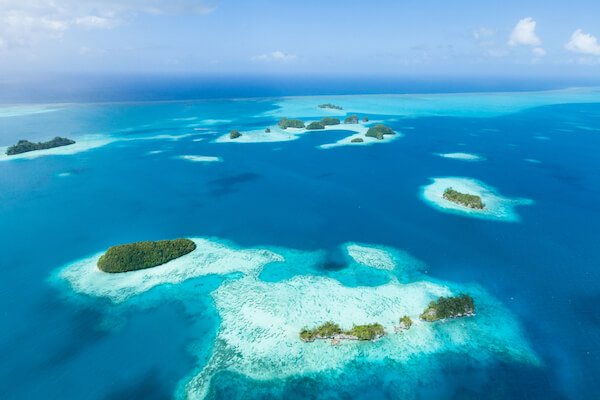 Pulau islands in the Pacific Ocean
Pulau islands in the Pacific Ocean15. Ocean Facts | How old are the oceans?
The oceans were formed more than 3.8 billion years ago and grew over millions of years when the gas from the earth interior escaped very slowly and condensed into rain. Gravity prevents the water from leaving our planet.
The oldest marine fossils date back about 3.4 billion years and were found in Western Australia.
16. What are important ocean products and resources?
The oceans are not only an important source of oxygen, water, fish and seafood for our basic needs, but also provide important natural resources such as oil and gas and are important for shipping and transporting of goods as well as for tourism.
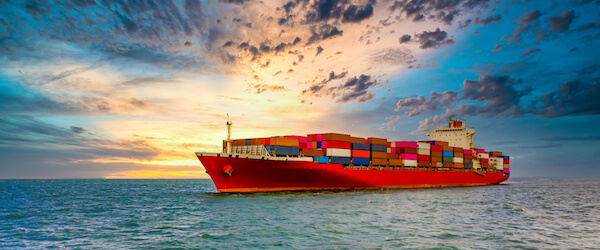 The Atlantic Ocean is a major transport route
The Atlantic Ocean is a major transport routeThe Atlantic Ocean is commonly referred to as the busiest ocean transport route for shipping. Most cargo ships pass the Atlantic Ocean.
17. Ocean Facts | What are biggest threats to our ocean?
The biggest threat to a healthy ocean are pollution, destruction and overfishing.
Destruction of ocean habitat by mining, sand dredging, overfishing or pollution through sewage, plastic and garbage leads to climate change, ocean warming and acidification of the ocean waters.
The tiny phytoplankton that lives in the oceans provide over 50% of our oxygen and due to pollution many ocean areas are already 'dead zones'. There are actually over 500 dead zones across our globe that cover a bigger area than the land area of the United Kingdom.
18. What is the Great Pacific Garbage Patch?
Actually there is more than one big garbage patch in our oceans. The two most prominent garbage patches in the North Pacific Ocean consist of marine debris, litter and very small pieces of plastic (so called micro plastics) that are unfortunately not that easy to spot by the naked eye.
Most of the micro plastics items are smaller than 5 mm/ 0.2 inches. These 'garbage patches' also constantly move with the ocean currents and winds.
19. How much of our oceans has been discovered and explored?
Only about 5% of our ocean has been explored and discovered so far. There is still much exploration work to do!
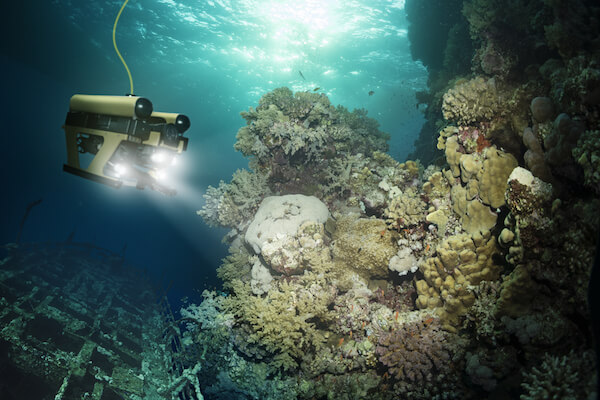
Among the great scientists and oceanographers who explore our oceans are: Jacque Cousteau, Rachel Carson, Silvia Earle and James Cameron.
20. How much of the ocean is protected?
Only about 1% of our oceans are fully protected marine areas such as marine reserves and national parks. Marine reserves are important to protect the marine life and the livelihood of people living in coastal regions.
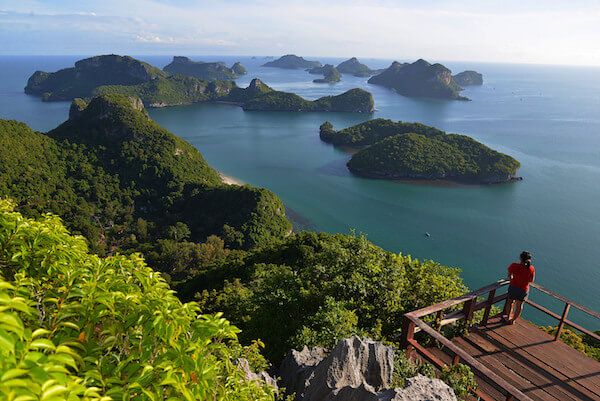 Ang Thong Marine Reserve Thailand
Ang Thong Marine Reserve ThailandOcean Facts: The oceans play also an important factor also in tourism in many countries such as Thailand.
Test your Ocean Knowledge
Ocean Facts Additional Info
Ocean Facts: Ocean Sizes
The Atlantic Ocean is about half the size of the Pacific Ocean and covers roughly 20% of the Earth's surface.
The smallest ocean is the Arctic Ocean which only covers about 2.8% of our earth. However, only about 5% of our world oceans have been explored so there is still lots to discover!
More Ocean Facts: Ocean Currents
The strongest ocean currents are driven by wind. The strongest current is the Antarctic Circumpolar Current which also carries 100 times more water than all the rivers in the world combined!
The fastest ocean current is the Gulf Stream. The strong and warm Atlantic ocean current originates in the Gulf of Mexico. The Gulf Stream is about 300 times as strong as the flow in the Amazon river! The average speed is 6.4 km per hour/ 4 miles per hour.
Ocean Facts: World Islands
The five biggest islands in the world's oceans are:
- Greenland (Denmark) - North Atlantic Ocean/Arctic Ocean
- New Guinea (shared by Papua New Guinea and Indonesia) - Pacific Ocean
- Borneo (shared by Malaysia and Indonesia) - Pacific Ocean
- Madagascar - Indian Ocean
- Baffin Island (Canada) - Arctic Ocean/North Atlantic Ocean
Islands are highly affected by climate change. Many island countries such as Vanuaty, Papua New Guinea, Fiji, Mauritius and Jamaica are among high risk countries for flooding.
Ocean Facts: Ocean Resources
Natural gas and oil fields are found in the ocean, however, these are not renewable energy sources. Other non renewal sources are sand and gravel that is excavated for building material, other minerals such as copper or nickel or precious stones such as diamonds.
Did you know that about 200 billion pound fish and shellfish are caught every year? Overfishing is a serious threat to our environment. Read here about sustainable seafood choices.
Protect our oceans to protect our human lives! Human life and the health of the oceans is interconnected.
Let's make sure we all do our best to keep the ocean healthy not only for us but the coming generations!
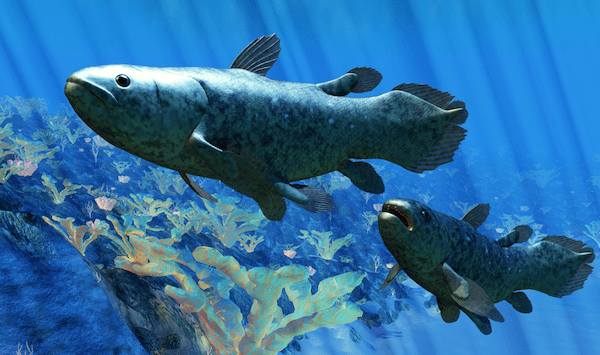 Coelacanths - ancient fish species found in the Deep Sea of the Indian ocean
Coelacanths - ancient fish species found in the Deep Sea of the Indian oceanWorld Ocean Facts: Popular Pages
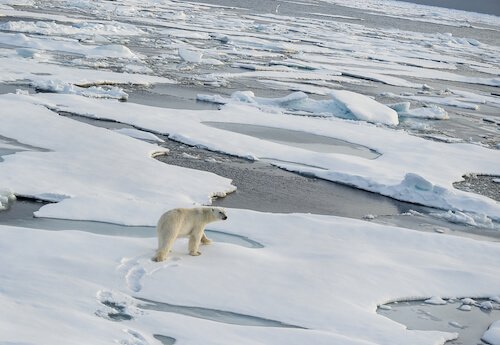 Arctic Ocean Arctic Ocean |
World Ocean Facts Resources
- Australian Government. "Reef facts." GBRMPA. Last accessed 8 June 2021
- World Wildlife Fund. "Deep Sea." WWF. Last accessed 8 June 2021
- MI News Network. 10 Deepest Parts of the Ocean." Marine Insight. Last updated 10 January 2020. Last accessed 8 June 2021.
- Emily Tripp. "Which Ocean Has the Most Marine Life." Marine Science Today. Last accessed 8 June 2021
- Polar Bears International. "Habitat." Pbears.org. Last accessed 8 June 2021.
- National Ocean Service. "Ring of Fire. Deep Sea Dive." Ocean Today. Last accessed 8 June 2021.
- Zulfikar Abbany. "Volcanoes and Earthquakes: The Pacific Ring of Fire." Deutsche Welle. 13 January 2020. Last accessed 8 June 2021.
- National Ocean Service. "What is the Great Pacific Garbage Patch?" Ocean Today. Last accessed 8 June 2021.
- UNESCO Natural Sciences. "Facts and Figures on Marine Biodiversity." UNESCO. Last accessed 8 June 2021.
- UN Atlas of the Oceans. "Human Settlements on the Coast." UN OceanAtlas. Last accessed 8 June 2020.
- Talia Lakritz. "These 11 Sinking Cities Could Disappear by 2100." World Economic Forum. 10 September 2019. Last accessed 8 June 2021
- LuAnn Dahlmann and Rebecca Lindsey. "Climate Change: Ocean Heat Content." NOAA Climate.gov. 13 February 2020. Last accessed 8 June 2021
Image Credits on Ocean Facts: shutterstock.com, sxc photos and own images
Return from Ocean Facts to Kids World Travel Guide Homepage
***
